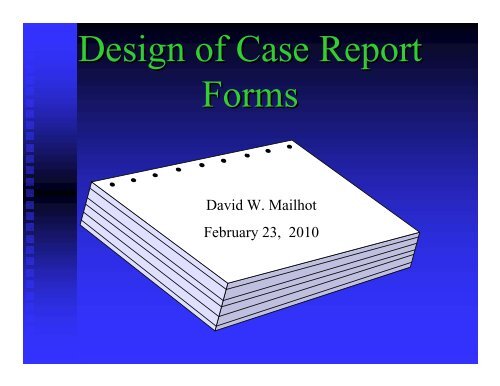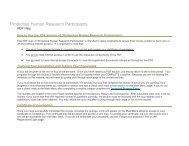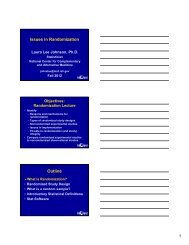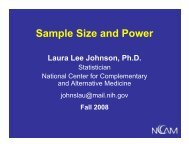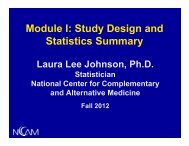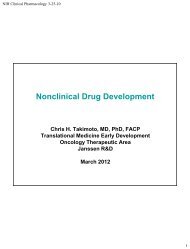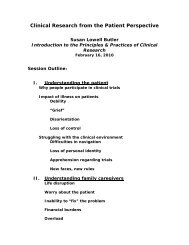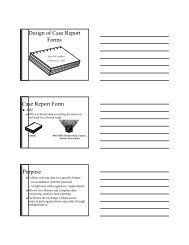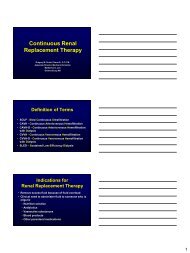Design of Case Report Forms
Design of Case Report Forms
Design of Case Report Forms
- No tags were found...
Create successful ePaper yourself
Turn your PDF publications into a flip-book with our unique Google optimized e-Paper software.
<strong>Design</strong> <strong>of</strong> <strong>Case</strong> <strong>Report</strong><strong>Forms</strong>David W. MailhotFebruary 23, 2010
<strong>Case</strong> <strong>Report</strong> Form• ..CRFOfficial clinical data-recording document ortool used in a clinical studyPAPERRDC/RDE (Remote Data Capture,Remote Data Entry)
PurposeCollects Collects relevant data in a specific format• in accordance with the protocol• compliance with regulatory requirementsAllows Allows for efficient and complete dataprocessing, analysis and reportingFacilitates the exchange <strong>of</strong> data acrossprojects and organizations especially throughstandardization
CRF Relationship toProtocolProtocol Protocol determines what data should becollected on the CRFAll All data must be collected on the CRF ifspecified in the protocolData Data that will not be analyzed should notappear on the CRF
ProtocolAnalysisPlanDescribes Study Conduct•purpose•objectives•operational aspectsDescribes Analysis•data presentations•key endpoints•statistical methods<strong>Case</strong><strong>Report</strong>FormCollects data to supportthe above
CRF Development• GuidelinesCollect Collect data outlined in the protocolCollect Collect data to support the analysis planCollect Collect data required by the regulatoryagencies
CRF Development• Guidelines (con(con’t)Collect Collect data with all users in mindBe Be clear and concise with your data questionsAvoid Avoid duplicationRequest Request minimal free text responsesProvide Provide units to ensure comparable valuesProvide Provide instructions to reducemisinterpretations
CRF Development• Guidelines (con(con’t)Provide Provide “choices” for questions where possibleUse Use <strong>of</strong> “None” and “Not done” for assesmentsCollect Collect data in a fashion that allows for themost efficient computerizationCollect Collect data and formats that provides forpooling across studiesCRF CRF book needs to be finalized and availablebefore an investigator starts enrolling patientsinto a study
Elements <strong>of</strong> the CRF• Three major parts:HeaderHeaderSafety Safety related modulesEfficacy Efficacy related modules• Moduleblock <strong>of</strong> specific questions• CRFmodule(s) make up a single CRF page• CRF Book series <strong>of</strong> CRF pages
Header Information• Key identifying Information• MUST HAVESStudy NumberSite/Center NumberSubject identification number
Creating Safety Modules• Ideally come from a standard library• Select modules appropriate for your study• Keep safety analysis requirements in mind• Safety Modules usually include• Demographic• Adverse Events• Vital Signs• Medical History/Physical Exam• Concomitant Medications• Patient Disposition/Status at end <strong>of</strong> study
Efficacy Modules• <strong>Design</strong>ed for each therapeutic area based on theprotocol• Primary and secondary efficacyendpoints/parameters• Health Outcomes Assessments/Questionnaires• Considered to be “unique” modules and can bemore difficult to develop• Use existing examples from similar protocolswhere applicable
Creating Efficacy Modules• Follow general CRF design guidelines• Include appropriate baseline measurements• Repeat same battery <strong>of</strong> tests• Define and identify• key efficacy endpoints• diagnostic tests for efficacy
Importance <strong>of</strong> StandardCRFs• Prepares the way for data exchange• Removes the need for mapping during dataexchange• Allows for consistent reporting across protocols,across projects• Promotes monitoring and investigator staffefficiency• Allows merging <strong>of</strong> data between studies• Provides increased efficiency in processing andanalysis <strong>of</strong> clinical data
CRF DevelopmentProcessCRF <strong>Design</strong>er•Drafts CRF from protocolReviewers• CRF Review Meeting• Comments back to designer• Updates CRF to include comments• Review and Sign <strong>of</strong>f/approval• Coordinate printing and distributionCRF <strong>Design</strong>erCRF BookSite
CRF Development Process• Responsibility for CRF design can vary betweenclinical research organizations (CRA, datamanager, specialty role)• Interdisciplinary review is necessary• Each organization has its own process forreview/sign-<strong>of</strong>f• Should include relevant members <strong>of</strong> theproject team involved in conduct, analysisand reporting <strong>of</strong> the trial• Begins• As soon as possible in the study planningprocess (draft protocol)
CRF Development Process• Review Team (example)• Clinician• CRA• Statistician• Programmer• Data Manager• Others• Database Development, Dictionary Coding,Standards
CRF Development Process• After the CRF book is approvedInitiate Initiate the process for printingNote: the Protocol must be approved before theCRF book is approved and printed• After it is printedStored Stored according to organizational guidelinesPrinted Printed and distributed to research sites
Properly <strong>Design</strong>ed CRF• Components/All <strong>of</strong> the CRF pages arereusable in future studies• Saves time• Saves money+
Poorly <strong>Design</strong>ed CRF• Necessary data not collected• Database may require modification• Data Entry process impeded• Need to review/clean data increases• Target dates are missed• Collected too much data – Wasted resources incollection and processing• Delay in getting study results and ability toadequately test the protocol objectives
The <strong>Case</strong> <strong>Report</strong> Form• How do we use it?• Collect data from the investigational sites• Helps project team and study site team• Reminder to investigator to performspecific evaluations• CRA uses to verify protocol is beingfollowed and compare with sourcedocuments• Statistics and Programming groups use itto build database structures, develop editchecks and programming specs
The <strong>Case</strong> <strong>Report</strong> Form• ...Data is Used for• Data analysis and reporting• Subject tracking• <strong>Report</strong>s to FDA on subject safety• Promotional materials• New Drug Application submissions• Support <strong>of</strong> labeling claims• Publication in medical journals
Electronic CRFs• The use <strong>of</strong> RDC is increasing• In general, the concepts for the design <strong>of</strong>electronic CRFs/RDC screens are the same as forpaper CRFs• Electronic CRFs will impact the following: Review <strong>of</strong> CRF is different (screen review) No need to print and distribute paper Responsibility for Data entry Data quality checks at source
Electronic CRFs and Data Capture• Types <strong>of</strong> SystemsDirect entry into active databaseEntry into local disc/holding file for laterloading/transferEntry with second review necessary inorder to change “status”
CRF Completion Guidelines• Used to give both general and specific guidance t<strong>of</strong>acilitate quality data collection• Partial Dates• Unknowns• Missed Visits• Unplanned visits• Discontinued Subjects• May also include navigation or technicalinstructions associated with an EDC system
Examples
Questions ?


